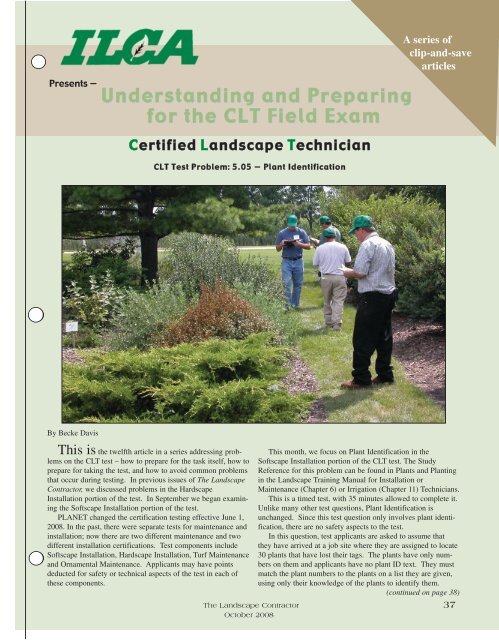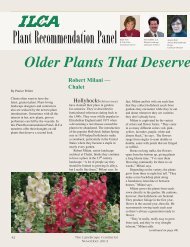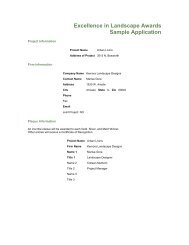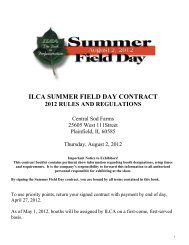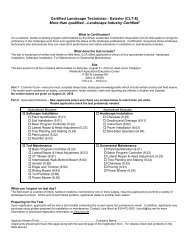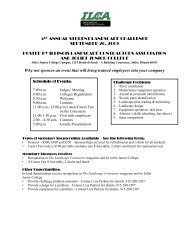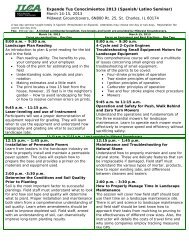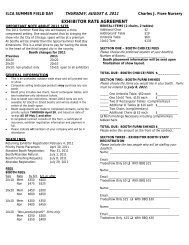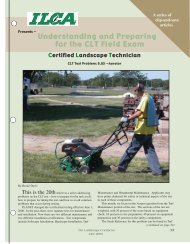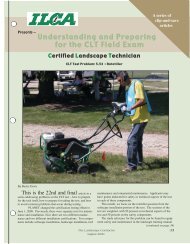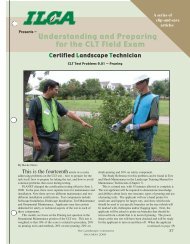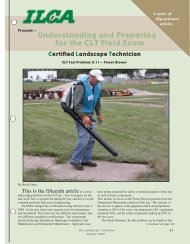test 1-5 - Illinois Landscape Contractors Association
test 1-5 - Illinois Landscape Contractors Association
test 1-5 - Illinois Landscape Contractors Association
- No tags were found...
You also want an ePaper? Increase the reach of your titles
YUMPU automatically turns print PDFs into web optimized ePapers that Google loves.
Presents —<br />
U n d e r s t a n d i n g a n d P r e p a r i n g<br />
f o r t h e C L T F i e l d E x a m<br />
Certified <strong>Landscape</strong> Technician<br />
CLT Test Problem: 5.05 — Plant Identification<br />
A series of<br />
clip-and-save<br />
articles<br />
By Becke Davis<br />
This is the twelfth article in a series addressing problems<br />
on the CLT <strong>test</strong> – how to prepare for the task itself, how to<br />
prepare for taking the <strong>test</strong>, and how to avoid common problems<br />
that occur during <strong>test</strong>ing. In previous issues of The <strong>Landscape</strong><br />
Contractor, we discussed problems in the Hardscape<br />
Installation portion of the <strong>test</strong>. In September we began examining<br />
the Softscape Installation portion of the <strong>test</strong>.<br />
PLANET changed the certification <strong>test</strong>ing effective June 1,<br />
2008. In the past, there were separate <strong>test</strong>s for maintenance and<br />
installation; now there are two different maintenance and two<br />
different installation certifications. Test components include<br />
Softscape Installation, Hardscape Installation, Turf Maintenance<br />
and Ornamental Maintenance. Applicants may have points<br />
deducted for safety or technical aspects of the <strong>test</strong> in each of<br />
these components.<br />
This month, we focus on Plant Identification in the<br />
Softscape Installation portion of the CLT <strong>test</strong>. The Study<br />
Reference for this problem can be found in Plants and Planting<br />
in the <strong>Landscape</strong> Training Manual for Installation or<br />
Maintenance (Chapter 6) or Irrigation (Chapter 11) Technicians.<br />
This is a timed <strong>test</strong>, with 35 minutes allowed to complete it.<br />
Unlike many other <strong>test</strong> questions, Plant Identification is<br />
unchanged. Since this <strong>test</strong> question only involves plant identification,<br />
there are no safety aspects to the <strong>test</strong>.<br />
In this question, <strong>test</strong> applicants are asked to assume that<br />
they have arrived at a job site where they are assigned to locate<br />
30 plants that have lost their tags. The plants have only numbers<br />
on them and applicants have no plant ID text. They must<br />
match the plant numbers to the plants on a list they are given,<br />
using only their knowledge of the plants to identify them.<br />
(continued on page 38)<br />
The <strong>Landscape</strong> Contractor 37<br />
October 2008
C L T F i e l d E x a m P r e p<br />
(continued from page 37)<br />
The use of reference materials is not<br />
allowed. The list of plants will contain<br />
both botanical Latin and common<br />
names.<br />
Dr. James Ethridge, department<br />
chair of horticultural<br />
sciences<br />
at Joliet<br />
Junior College<br />
(JJC), is an<br />
ILCA member<br />
and chairman<br />
of the education<br />
portion of<br />
the CLT<br />
Committee.<br />
Dr. Ethridge<br />
has been at JJC<br />
since 1983.<br />
Prior to that, he<br />
taught at the<br />
University of<br />
<strong>Illinois</strong> at<br />
Champaign-<br />
Urbana, where<br />
he also<br />
received his<br />
Batchelor’s and<br />
Master’s<br />
degrees and<br />
Ph.D.<br />
Each state<br />
that offers CLT<br />
<strong>test</strong>ing selects<br />
the 150 most<br />
commonly used<br />
landscape<br />
plants in their<br />
state and, from those 150 plants, 30 are<br />
selected for the Plant Identification <strong>test</strong><br />
question. A different 30 plants are<br />
selected each time the <strong>test</strong> is given. In<br />
<strong>Illinois</strong>, ILCA members are surveyed to<br />
compile the list of 150 plants that form<br />
the pool used in this <strong>test</strong> and Dr.<br />
Ethridge is charged with selecting the<br />
30 plants that will be used on any given<br />
<strong>test</strong> day.<br />
“There are six or seven categories of<br />
plants, including trees, shrubs,<br />
broadleaf evergreens, vines, grasses<br />
and annuals and perennials,” Dr.<br />
Ethridge explains. “I have to make<br />
sure to include a representative sample<br />
of plants from each group.” The most<br />
common reason <strong>test</strong> applicants fail this<br />
<strong>test</strong> question is that they aren’t familiar<br />
with all the categories of plants, he<br />
says. “If they work with a tree crew,<br />
they may know trees but not annuals<br />
and perennials,” he observes. “If they<br />
are in a crew that installs bedding<br />
plants, they may know annuals but not<br />
woody plants. Some people fail half<br />
the <strong>test</strong> for this reason.”<br />
Another problem might be that the<br />
<strong>test</strong> applicants are able to distinguish<br />
between a maple and an oak or a pine,<br />
but they aren’t able to tell one species<br />
of maple from another. “If there are<br />
two maples on the <strong>test</strong> and they get one<br />
of those wrong, that means the other is<br />
going to be wrong, too,” says Dr.<br />
Ethridge. If<br />
someone is<br />
retaking the <strong>test</strong>,<br />
he may ask to<br />
see which questions<br />
the applicant<br />
missed on<br />
the original <strong>test</strong><br />
so he can<br />
include the<br />
plants that were<br />
wrongly identified<br />
the first<br />
time around.<br />
On the other<br />
hand, he says,<br />
he might put<br />
completely different<br />
plants on<br />
the re<strong>test</strong>. There<br />
are 150 possibilities,<br />
and every<br />
time he gives<br />
the <strong>test</strong> he’s<br />
likely to pick a<br />
different 30<br />
plants.<br />
“These are<br />
real plants,” he<br />
stresses. “No<br />
slides, no pictures,<br />
just real<br />
plants either in the ground or landscape-size<br />
plants in a container.<br />
They’re in random order, not alphabetical.<br />
Students in college have to spell<br />
the Latin names right, but this <strong>test</strong> is<br />
multiple choice with the Latin name<br />
and common name spelled out.”<br />
In other words, the <strong>test</strong> is pretty<br />
easy for applicants who know their<br />
plants —but if they don’t know the<br />
plant material, it’s another story.<br />
38 The <strong>Landscape</strong> Contractor<br />
October 2008
“Someone who works on a lawn crew<br />
may not need to know plant material,”<br />
says Dr. Ethridge. “But a foreman ought<br />
to know — and there is a higher standard<br />
for CLTs.”<br />
The woody plants used in the Plant<br />
Identification<br />
<strong>test</strong> are all in<br />
the ground at<br />
Joliet Junior<br />
College. The<br />
herbaceous<br />
plants are in<br />
JJC’s greenhouse.<br />
Dr.<br />
Ethridge<br />
notes that <strong>test</strong><br />
applicants<br />
can visit the<br />
greenhouse<br />
to study the<br />
plants<br />
Monday<br />
through<br />
Friday from<br />
8 a.m. to 4<br />
p.m., and the<br />
grounds can<br />
be visited<br />
anytime.<br />
While <strong>test</strong><br />
applicants<br />
can study the<br />
plants, they<br />
will have no<br />
way of<br />
knowing<br />
which 30<br />
plants will be<br />
included on the day they take the CLT<br />
<strong>test</strong>.<br />
Annuals and perennials may not be<br />
in bloom at the time of the <strong>test</strong>, but Dr.<br />
Ethridge says he will sometimes seek<br />
out plants that are going to be out-ofseason<br />
and keep them in the greenhouse<br />
until <strong>test</strong> day. He doesn’t always select<br />
plants in pristine condition, so applicants<br />
may find it necessary to identify a<br />
plant by its twigs or buds. Dr. Ethridge<br />
says that one year there was a bad infestation<br />
of Japanese beetles, and he selected<br />
some plants with severely damaged<br />
foliage. He says <strong>test</strong> applicants “should<br />
know what the plant looks like even if<br />
the foliage is damaged.”<br />
All of the 150 plants that form the<br />
core of this <strong>test</strong> are plants commonly<br />
found in<br />
<strong>Illinois</strong><br />
landscapes<br />
– the <strong>test</strong><br />
doesn’t<br />
have trick<br />
questions<br />
or rare,<br />
exotic<br />
plants<br />
designed<br />
to fool the<br />
<strong>test</strong> applicant.<br />
Applicants<br />
whose<br />
knowledge<br />
is<br />
limited to<br />
one or two<br />
plant categories<br />
would be<br />
well<br />
served to<br />
stop by<br />
Joliet<br />
Junior<br />
College<br />
and see<br />
how many<br />
plants<br />
they can<br />
identify on the grounds and the greenhouse.<br />
Familiarity with the plants and<br />
knowledge of their identifying characteristics<br />
is the only way to go into this<br />
<strong>test</strong> with confidence.<br />
Every article in this series is also<br />
available on the ILCA website at www.<br />
ilca.net/certification.aspx<br />
The <strong>Landscape</strong> Contractor 39<br />
October 2008


